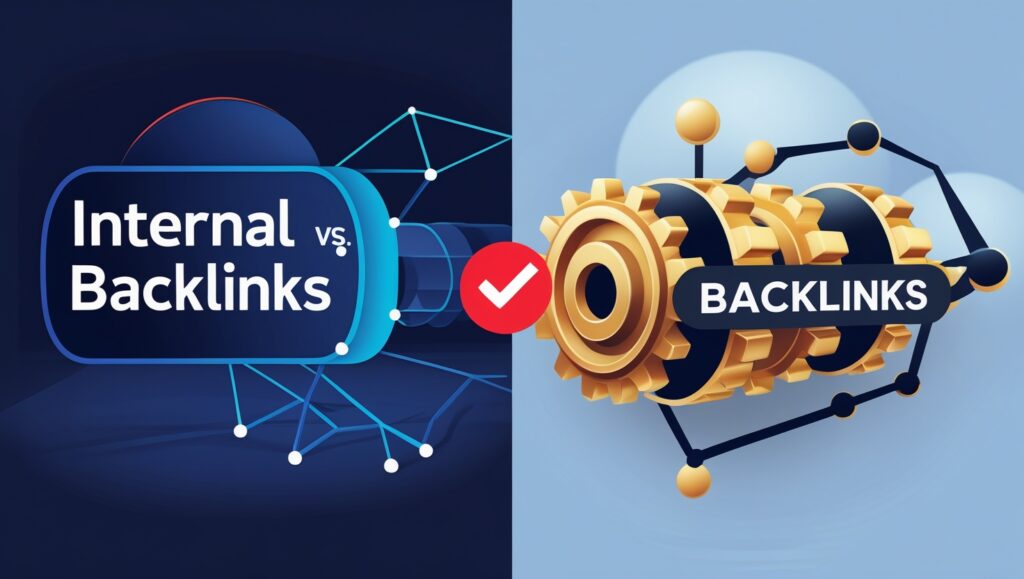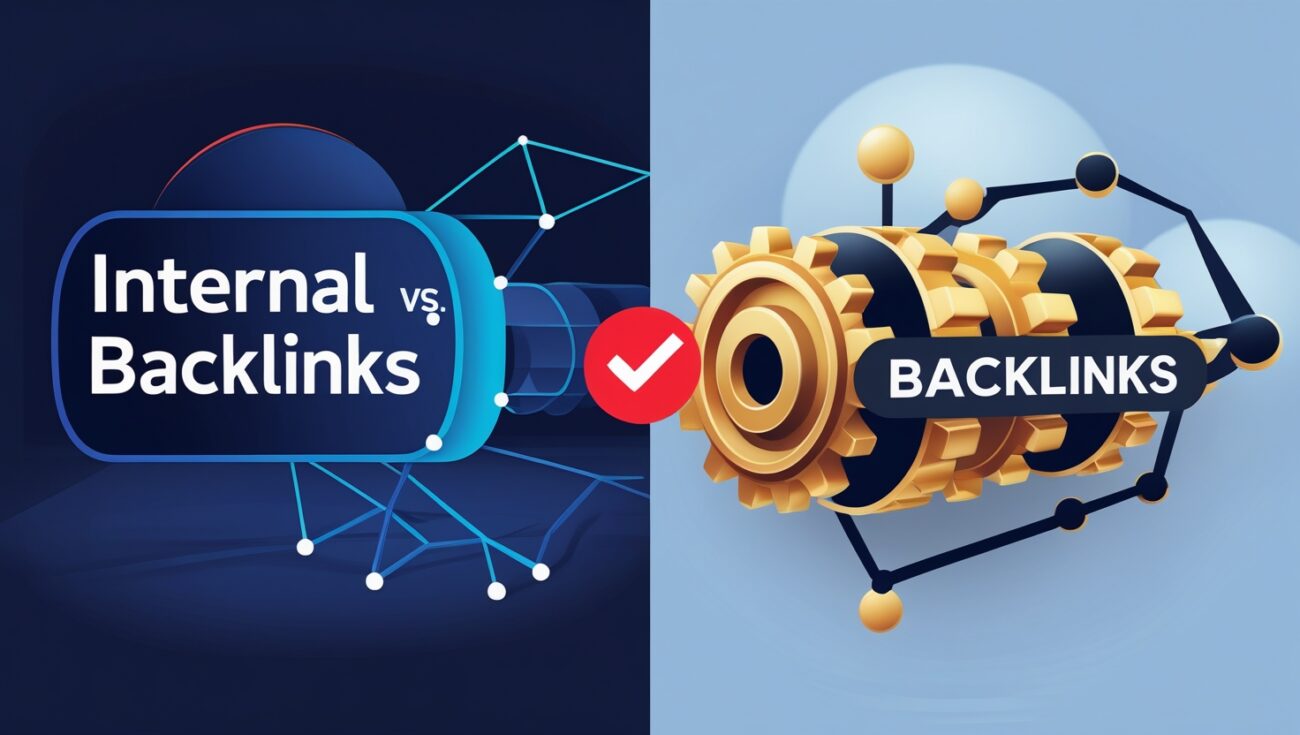Internal Links vs Backlinks: What Matters Most for SEO?
For years, I was obsessed with one thing: backlinks. The SEO world, from a beginner’s perspective, often makes it seem like they are the single most important factor for ranking. I spent countless hours reaching out to other websites, writing guest posts, and trying to secure a single link back to my site.

Table of Contents
While I did see some results, the process was slow, unpredictable, and frankly, exhausting. I had a narrow view of how Google works, and it wasn’t until I took a step back that I realized the crucial role I was missing: the foundational power of internal links.
The question isn’t whether one is more important than the other. The true magic happens when you understand the unique role of each and how they work together. One is about external validation, and the other is about internal organization. Let me break down the case for both and show you why a holistic approach is the only way to win in today’s SEO landscape.
The Case for Backlinks
- Backlinks as a “Vote of Confidence”: A backlink from another website is still one of the most powerful signals you can send to Google. It’s a vote of confidence, telling the search engine, “This website is an authoritative and trustworthy source of information.” A high-quality backlink from a well-respected site can instantly boost your own site’s authority.
- Backlinks as a Credibility Signal: In Google’s eyes, earning backlinks is a strong indicator that you are a credible authority in your niche. They are a sign of popularity and expertise that a search engine uses to determine whether to trust and rank your content.
- The Challenge with Backlinks: The problem is, you have no direct control over them. You can’t force another website to link to you. The process is often slow, requires significant effort, and the results are never guaranteed.
The Foundational Power of Internal Links
- Internal Links as a “Roadmap”: Unlike backlinks, internal links are completely within your control. They are the pathways that guide Google’s crawlers through your website, helping them discover and index all of your valuable content. A well-structured internal link profile makes your site easy for a bot to navigate, which is a major win.
- Internal Links as a “Signal of Relevance”: Every internal link you add helps to define your site’s structure and demonstrates your topical authority. By linking related articles together, you are helping Google understand what your website is truly about, which can lead to higher rankings for a wider variety of keywords.
- The Big Advantage: This is the key difference. You don’t have to wait for anyone else to link to you. You can start building a powerful internal link profile right now, today, without a single cent of ad spend.
So, What Matters Most? The Verdict
The real answer is that they work together. Backlinks bring authority and credibility to your website from the outside world, like a high-five from another expert. But that authority lands on a single page, and if that page isn’t well-linked, that authority goes nowhere.
This is where the magic happens. Your internal links are the circulatory system of your website. They take the authority brought in by your backlinks and distribute it throughout your entire site, to all of your most important pages. Without a strong internal link structure, the power of a great backlink is limited to a single page. I use a tool that helps me manage this process and unlock the full potential of my backlinks.
The Role of Automation in Unlocking Both Powers
Manually identifying your most authoritative pages and linking them to your most important content is incredibly time-consuming. You have to find every orphaned page and every opportunity to pass valuable link equity. Automated internal linking software can analyze your website and provide you with a prioritized, actionable list of opportunities to fix these issues. With Linkbot, you can take control of your internal link profile and unlock the full potential of your backlinks.
Conclusion: The Symbiotic Relationship
Stop thinking about internal links vs backlinks. Start thinking about internal links and backlinks. One brings in the trust, and the other spreads it around. A website that has a strong profile of both is a website that will dominate its niche.
By mastering the one you have complete control over—internal linking—you are building a foundational asset that will help your site get the most out of every backlink it earns. Don’t let your valuable backlinks go to waste; start building a smarter internal link structure with Linkbot today.
One of the most immediate and tangible differences between these two is the cost. While backlinks can cost thousands of dollars in outreach, content creation, or paid services, a robust internal linking strategy is essentially free. It’s a low-cost, high-impact tactic that puts all the power back in your hands, making it the most sensible first step for any website owner, especially those with a limited budget.
A well-maintained internal link profile sends a strong signal to Google that your site is a living, breathing, and valuable resource. When Google’s bots see that you are regularly adding new links, fixing broken ones, and thoughtfully connecting your content, it reinforces the idea that your site is a reliable source of information, which can positively impact your rankings.
Ultimately, a great user experience is the goal of both link types. A backlink brings a user to your site, but a strong internal link profile keeps them there, guiding them to more helpful information. This synergy leads to lower bounce rates and higher time-on-page metrics, which Google’s algorithm observes as positive signals of a high-quality website.
The most powerful thing about a consistent strategy for both is their compounding effect. Each high-quality backlink you earn brings more authority to your site, and each new internal link you add helps to distribute that authority more effectively. The two work together to create a flywheel of growth that continues to build momentum over time, ensuring your SEO efforts aren’t a one-time win but a long-term strategy.
My journey taught me that a major mistake is thinking of the two link types as a choice. A website with strong internal links is like a beautifully organized home. A backlink is a respected guest who shows up with a high-five and a compliment. You need both for a successful and welcoming house, and they are stronger together.
One of the greatest benefits I got from using an automated tool to manage my internal links was the “to-do” list it provided. Instead of being overwhelmed by the sheer size of my website, the tool gave me a prioritized, actionable list of connections to make. It transformed a monumental, frustrating task into a series of manageable steps that I could tackle in just minutes.
I had to make a fundamental mental shift. I moved my focus from obsessing about what other websites were doing (backlinks) to obsessing about what I could control on my own website (internal links). This change in perspective was empowering and helped me focus on building a strong, reliable SEO foundation that I could count on.
Consider a specific example: you land a powerful backlink from a major publication to a single blog post. That’s a huge win! But if that blog post has no internal links to your other content, the authority dies there. By adding a few strategic internal links to your most important service pages or products, you are effectively taking that authority and spreading its power throughout your entire website, making every page stronger.
A well-organized internal link structure can also help you earn more backlinks naturally. When an external writer or content creator is looking for a resource to link to, they are more likely to link to a website that is a clear, trustworthy, and well-organized hub of information. Your clean internal structure signals that you are an expert and a reliable source.
I had to learn the difference between building a link “profile” and building a link “network.” Your backlink profile is a collection of votes from other sites. Your internal link network is the purposeful web of connections that you build yourself. One is external; the other is internal. Both are essential for a healthy website.
I felt like I was finally in the driver’s seat of my SEO. For years, I had relied on external factors, which felt like I was giving up control of my SEO destiny. But by mastering my internal links, I was proactively building my site’s authority from the inside out, on my own terms, which was an empowering and exciting feeling.
Ultimately, both internal links and backlinks have different but equally essential roles. One is the external validation that brings trust to your site, and the other is the internal system that distributes that trust. They are a team, and understanding how they work together is the key to unlocking your full SEO potential.

